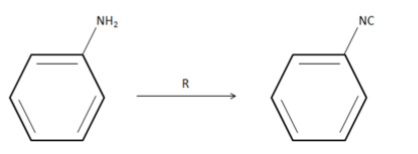
Find the reactant R in the following reaction

(1) ${N_2}$
(2) $CHC{l_3}/KOH(alcoholic)$
(3) $N{H_3}$
(4) $KCN$

Answer
555.9k+ views
Hint:An extra Carbon atom is being substituted so check of options that have a carbon atom in them. Clearly there are no other reagents so the $ - NC$ molecule that is substituted in the place of $ - N{H_2}$ must be from the reaction between aniline and the reactant R.
Complete answer:
Given to us, aniline has to be converted to phenyl isocyanide. When we treat aniline with chloroform in presence of a strong base such as alcoholic $KOH$ in this case, phenyl isocyanide is formed. This reaction is known as carbylamine reaction. In this reaction, first we need to attach a carbon to the Nitrogen of amine group in aniline. So when chloroform reacts with aniline, nitrogen atom is attached to the carbon atom eliminating $HCl$ molecule. When this reaction takes place in the presence of alcoholic $KOH$ we get phenyl isocyanide.
Hence, the reagent R is $CHC{l_3}/KOH(alcoholic)$ i.e. option 2.
Additional information:
Carbylamine reaction is also known as Hofmann isocyanide synthesis. This process involves the formation of isocyanide by the reaction between an aliphatic or an aromatic primary amide, chloroform and a base. Secondary and tertiary amines do not give this reaction.
Note:
In the reaction given to us, a primary amide is being converted to an isocyanide in the presence of a reagent R. This reaction can be explained by carbylamine reaction or Hoffmann isocyanide synthesis. In this reaction a primary amide is treated with chloroform and a strong base to form an isocyanide.
Complete answer:
Given to us, aniline has to be converted to phenyl isocyanide. When we treat aniline with chloroform in presence of a strong base such as alcoholic $KOH$ in this case, phenyl isocyanide is formed. This reaction is known as carbylamine reaction. In this reaction, first we need to attach a carbon to the Nitrogen of amine group in aniline. So when chloroform reacts with aniline, nitrogen atom is attached to the carbon atom eliminating $HCl$ molecule. When this reaction takes place in the presence of alcoholic $KOH$ we get phenyl isocyanide.
Hence, the reagent R is $CHC{l_3}/KOH(alcoholic)$ i.e. option 2.
Additional information:
Carbylamine reaction is also known as Hofmann isocyanide synthesis. This process involves the formation of isocyanide by the reaction between an aliphatic or an aromatic primary amide, chloroform and a base. Secondary and tertiary amines do not give this reaction.
Note:
In the reaction given to us, a primary amide is being converted to an isocyanide in the presence of a reagent R. This reaction can be explained by carbylamine reaction or Hoffmann isocyanide synthesis. In this reaction a primary amide is treated with chloroform and a strong base to form an isocyanide.
Recently Updated Pages
A man running at a speed 5 ms is viewed in the side class 12 physics CBSE

The number of solutions in x in 02pi for which sqrt class 12 maths CBSE

State and explain Hardy Weinbergs Principle class 12 biology CBSE

Write any two methods of preparation of phenol Give class 12 chemistry CBSE

Which of the following statements is wrong a Amnion class 12 biology CBSE

Differentiate between action potential and resting class 12 biology CBSE

Trending doubts
What are the major means of transport Explain each class 12 social science CBSE

Which are the Top 10 Largest Countries of the World?

Draw a labelled sketch of the human eye class 12 physics CBSE

How much time does it take to bleed after eating p class 12 biology CBSE

Explain sex determination in humans with line diag class 12 biology CBSE

Explain sex determination in humans with the help of class 12 biology CBSE




